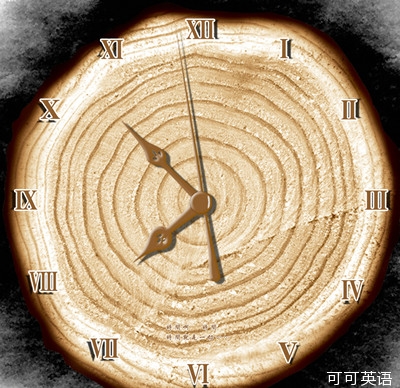科學(xué)技術(shù)
Dendrochronology
樹(shù)木年代學(xué)
Not always the ring of truth
年輪不一定反映事實(shí)
The use of wood to assess past environments needs care
通過(guò)樹(shù)木判斷過(guò)去的環(huán)境時(shí)要小心了
TREE rings are Mother Nature's history books.
年輪是大自然的史書(shū)。
Researchers often look at chemicals stored in them when trying to reconstruct past environments.
在試圖重現(xiàn)過(guò)去的環(huán)境時(shí),研究人員經(jīng)常會(huì)從年輪中所含的化學(xué)物質(zhì)入手。
Like all history books, though, they can be unreliable.
然而就和所有的史書(shū)一樣,年輪也并不怎么靠譜。
And in the case of one particular chemical of interest, mercury, Jose Antonio Rodriguez Martin of the National Institute for Agricultural and Food Research and Technology, in Madrid, and his colleagues have just shown how unreliable they are.
通過(guò)其關(guān)注的一個(gè)特別的化學(xué)物質(zhì)-汞,西班牙國(guó)家農(nóng)業(yè)與食物研究及技術(shù)學(xué)會(huì)的何塞·安東尼奧·羅德里格斯·馬丁及其同事便剛剛證明了年輪多么不靠譜。
 Dr Rodriguez Martin was studying pines on La Palma, in the Canary Islands.
Dr Rodriguez Martin was studying pines on La Palma, in the Canary Islands.
羅德里格斯·馬丁博士一直在研究拉帕爾馬島上的松樹(shù)。
He knew that Hoyo Negro, one of the island's volcanoes, had erupted violently in 1949, and believed that the clouds of ash and explosive ejections of rock from the eruption had destroyed all of the pines nearby.
他知道該島上的霍約內(nèi)格羅火山曾于1949年發(fā)生過(guò)劇烈噴發(fā),并認(rèn)為噴發(fā)產(chǎn)生的火山灰及迸散的巖石摧毀了附近所有的松樹(shù)。
However, as he describes in Naturwissenschaften, when he and his team examined the area, they were stunned to discover a revenant from this cataclysm just 50 metres from the crater.
然而,正如他在《自然科學(xué)》雜志上所說(shuō),當(dāng)他和自己的團(tuán)隊(duì)對(duì)該區(qū)域進(jìn)行調(diào)查時(shí),在離火山口僅50米的地方發(fā)現(xiàn)了一棵劫后余生的松樹(shù),讓他們震驚不已。
Like a battle-scarred soldier, this now-great pine had many half-healed wounds in its trunk.
就像一名身經(jīng)百戰(zhàn)的士兵,這棵現(xiàn)已長(zhǎng)成參天大樹(shù)的松樹(shù)的樹(shù)干上疤痕累累。
It had survived those. It did not, however, survive Dr Rodriguez Martin's axe.
這些傷口沒(méi)讓它倒下,但卻沒(méi)有逃過(guò)羅德里格斯·馬丁博士的斧頭。
He reluctantly felled it and, for comparison, collected a tree of similar age that was growing 400 metres from the eruption site, and another that was 16km away.
羅德里格斯·馬丁博士忍痛將它放倒,并分別從離噴發(fā)點(diǎn)400米及16千米處砍倒兩棵與其樹(shù)齡相同的松樹(shù)進(jìn)行比較。
One unpleasant element often ejected in volcanic eruptions is mercury.
火山噴發(fā)時(shí)經(jīng)常會(huì)噴射出一種不怎么好的元素-汞。
That was certainly the case in 1949, as soil-sampling showed.
正如土壤采樣所示,1949年的火山噴發(fā)確實(shí)釋放出了汞元素。
The question was, how much of it had got into the trees·
但問(wèn)題是,有多少進(jìn)入了樹(shù)體中?
Mercury falling
脫落的汞
When he analysed the survivor's scar tissue Dr Rodriguez Martin found high levels of the metal in it:
當(dāng)羅德里格斯·馬丁博士分析了這棵幸存的樹(shù)上的疤痕組織后,他發(fā)現(xiàn)其中的汞元素含量很高:
more than 22 micrograms per kilogram of wood.
每公斤木材中超過(guò)22毫克。
That was not surprising, given that this tissue would have formed soon after the eruption.
這并不出人意料,因?yàn)樵摻M織是在火山噴發(fā)不久后形成的。
What was surprising was that the wood of the survivor tree's rings had only 2.3 micrograms of mercury per kilogram in it.
出人意料的是這棵幸存的樹(shù)中年輪的木質(zhì)中每公斤僅含2.3毫克汞。
More surprising still, the rings of the other two trees were mercury-free, despite there being mercury in nearby soil.
更讓人大跌眼鏡的是,其他兩棵書(shū)的年輪中汞含量為零,盡管其附近的土壤中含有汞。
Tree rings are made of tissue called xylem.
構(gòu)成年輪的組織被稱(chēng)為木質(zhì)部。
This is a set of channels that carry water and minerals from the soil to the leaves, so its composition might be expected to reflect what is in the soil.
這是從土壤中將水合礦物質(zhì)輸送至葉片的一組通道,所以其組分應(yīng)該能夠反映出土壤中的組分。
A second set of channels, the phloem, found just under a tree's bark, carries the products of photosynthesis to the roots.
第二組通道叫韌皮部,就長(zhǎng)在樹(shù)皮之下,它將光合作用的產(chǎn)物輸送到樹(shù)的根部。
This tissue, however, is not preserved from year to year.
然而該組織每年都會(huì)更新。
When Dr Rodriguez Martin sampled the phloem of the trees he had chopped down, he found it much richer in mercury than their xylem.
羅德里格斯·馬丁博士對(duì)被他砍倒的樹(shù)的韌皮部采樣后,他發(fā)現(xiàn)韌皮部的汞含量比木質(zhì)部的要高。
Phloem from the tree at the eruption site had 9.5 micrograms of the metal per kilogram.
位于噴發(fā)點(diǎn)的樹(shù)上的韌皮部中每千克含有9.5毫克汞。
The two more distant trees had 2.9 and 2.0 respectively.
另外兩棵較遠(yuǎn)的樹(shù)的韌皮部每千克汞含量分別為2.9及2.0。
The explanation for the discrepancy lay in the trees' bark.
產(chǎn)生這種差異的原因就藏在樹(shù)皮之中。
This had similar mercury levels to the phloem.
樹(shù)皮的汞含量與韌皮部相近。
What Dr Rodriguez Martin reckons is going on is that trees are using their bark, which they shed continually, as a waste-disposal system.
羅德里格斯·馬丁博士認(rèn)為是這么回事:樹(shù)木將其不斷脫落樹(shù)皮當(dāng)做一種廢物處理系統(tǒng)。
Mercury is carried there by the phloem and selectively deposited in it, rather than in the plants' more permanent parts.
汞通過(guò)韌皮部被轉(zhuǎn)運(yùn)到樹(shù)皮中,有選擇性地在其中沉積,而非在自己不易更新的部位沉積。
The metal is then got rid of when the bark is sloughed off.
然后當(dāng)樹(shù)皮脫落時(shí),其中的汞也隨之被除去。
That makes it invisible to researchers who come along later. What happens to mercury, moreover, might well happen to other toxic materials.
這使隨后而來(lái)的研究人員無(wú)法發(fā)現(xiàn)汞的存在。而且,在汞身上出現(xiàn)的情況很可能也會(huì)出現(xiàn)在其他有毒物質(zhì)上。
That could throw the calculations of palaeoecologists severely out of kilter.
這會(huì)讓古生態(tài)學(xué)家的推測(cè)嚴(yán)重失準(zhǔn)。
All of which is a caution to those who read the Book of Tree Rings for clues to what happened in the past.
對(duì)于那些在年輪史書(shū)中尋找線(xiàn)索來(lái)了解過(guò)去發(fā)生了什么的人來(lái)說(shuō),所有這些都是一個(gè)警示。
Trees, it seems, are as good as rewriting history as people are.
樹(shù)木,似乎和人一樣精于改寫(xiě)歷史。
 Dr Rodriguez Martin was studying pines on La Palma, in the Canary Islands.
Dr Rodriguez Martin was studying pines on La Palma, in the Canary Islands.
 Dr Rodriguez Martin was studying pines on La Palma, in the Canary Islands.
Dr Rodriguez Martin was studying pines on La Palma, in the Canary Islands.